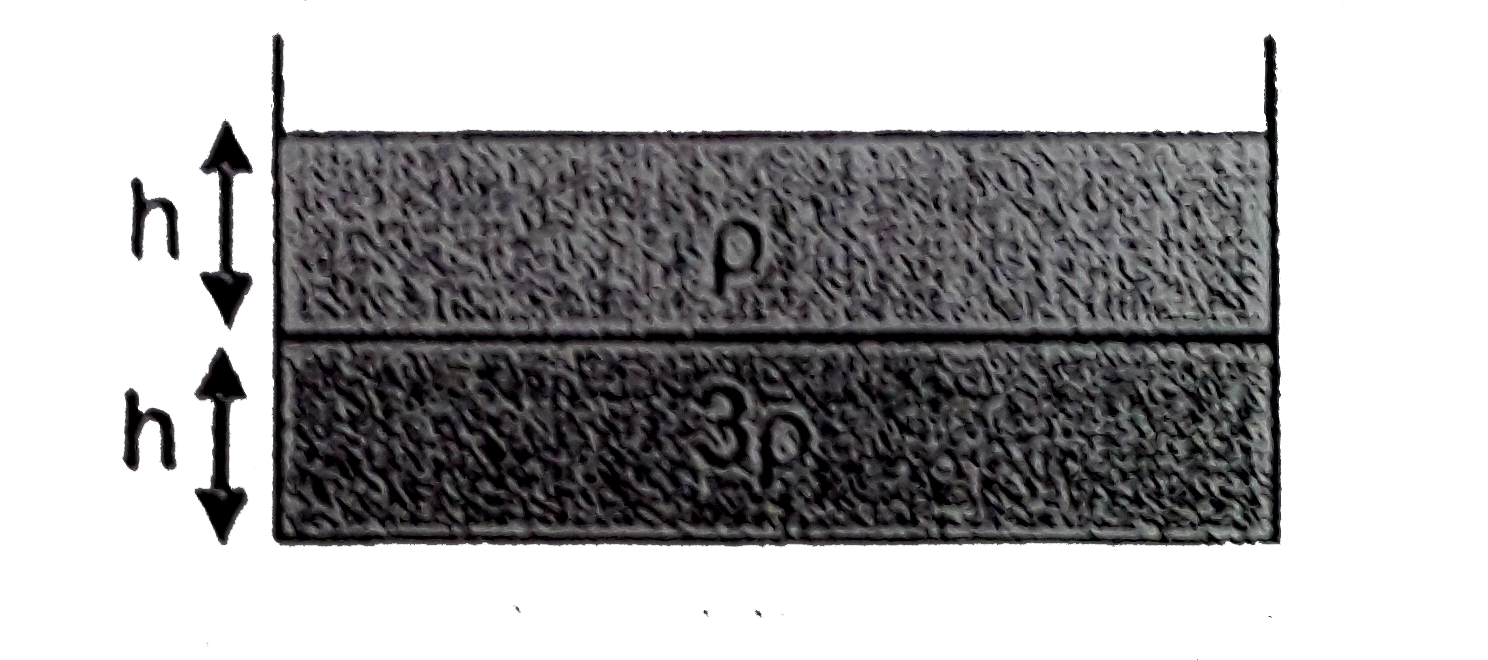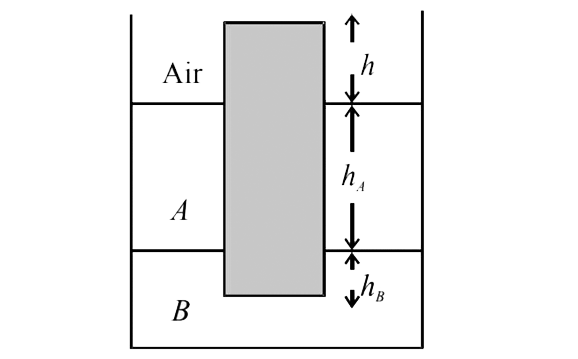Two miscible liquids of densities 1.2gm/cm and 1.4gm/cm aer mixed with a proportion ratio of their volumes equal to 2.5: what is the density of redulting liquid?
To find the density of the resulting liquid when two miscible liquids are mixed, we can use the formula for the density of a mixture. Here’s a step-by-step solution:
Step 1: Identify the given values
- Density of liquid 1, ρ1=1.2g/cm3
- Density of liquid 2, ρ2=1.4g/cm3
- Volume ratio of liquid 1 to liquid 2, V1:V2=2.5:1
Step 2: Express volumes in terms of a common variable
Let’s denote the volume of liquid 2 as V2=V. Then, the volume of liquid 1 can be expressed as:
V1=2.5V
Step 3: Calculate the total volume
The total volume Vtotal of the mixture is:
Vtotal=V1+V2=2.5V+V=3.5V
Step 4: Calculate the mass of each liquid
The mass of liquid 1, m1, is given by:
m1=ρ1×V1=1.2g/cm3×2.5V=3.0V
The mass of liquid 2, m2, is given by:
m2=ρ2×V2=1.4g/cm3×V=1.4V
Step 5: Calculate the total mass
The total mass mtotal of the mixture is:
mtotal=m1+m2=3.0V+1.4V=4.4V
Step 6: Calculate the density of the resulting mixture
The density ρmix of the resulting liquid can be calculated using the formula:
ρmix=mtotalVtotal
Substituting the values we have:
ρmix=4.4V3.5V=4.43.5
Step 7: Simplify the expression
Now, we can simplify 4.43.5:
ρmix=1.2571g/cm3
Final Result
Thus, the density of the resulting liquid is approximately:
ρmix≈1.26g/cm3
- Density of liquid 1, ρ1=1.2g/cm3
- Density of liquid 2, ρ2=1.4g/cm3
- Volume ratio of liquid 1 to liquid 2, V1:V2=2.5:1
Let’s denote the volume of liquid 2 as V2=V. Then, the volume of liquid 1 can be expressed as:
V1=2.5V
The total volume Vtotal of the mixture is:
Vtotal=V1+V2=2.5V+V=3.5V
The mass of liquid 1, m1, is given by:
m1=ρ1×V1=1.2g/cm3×2.5V=3.0V
m2=ρ2×V2=1.4g/cm3×V=1.4V
The total mass mtotal of the mixture is:
mtotal=m1+m2=3.0V+1.4V=4.4V
The density ρmix of the resulting liquid can be calculated using the formula:
ρmix=mtotalVtotal
ρmix=4.4V3.5V=4.43.5
Now, we can simplify 4.43.5:
ρmix=1.2571g/cm3
Thus, the density of the resulting liquid is approximately:
ρmix≈1.26g/cm3
Topper's Solved these Questions
- BOOK - ALLENCHAPTER - ELASTICITY, SURFACE TENSION AND FLUID MECHANICSEXERCISE - Exercise 1 (Elasticity)16videos
ELASTICITY, SURFACE TENSION AND FLUID MECHANICS
- BOOK - ALLENCHAPTER - ELASTICITY, SURFACE TENSION AND FLUID MECHANICSEXERCISE - Exercise 1 (Surface Tension)21videos
ELASTICITY, SURFACE TENSION AND FLUID MECHANICS
- BOOK - ALLENCHAPTER - CENTRE OF MASSEXERCISE - EXERCISE-V B19videos
CENTRE OF MASS
- BOOK - ALLENCHAPTER - ERROR AND MEASUREMENTEXERCISE - Part-2(Exercise-2)(B)22videos
ERROR AND MEASUREMENT
Similar Questions
Knowledge Check
- Question 1 - Select One
Two capillary tubes of radii 0.2 cm and 0.4 cm are dipped in the same liquid.The ratio of heights through which liquid will rise in the tube is
A1:2B2:1C1:4D4:1
Two liquids of densities 2ρ and ρ having their volumes in the ratio 3:2 are mixed together. Density of the mixture will be
View SolutionIf equal masses of two liquids of densities d1andd2 are mixed together, the density of the mixture is
View SolutionEqual volumes of two immiscible liquids of densities ρ and 3ρ are filled in a big vessel. Two small holes are punched at depth h/3 and 4h/3 from upper surface of lighter liquid. If v1 and v2 are velocities of efflux at these two holes, then v1/v2 is
 View Solution
View SolutionA uniform solid cylinder of density 0.8g/cm3 floats in equilibrium in a combination of two non-mixing liquids A and B with its axis vertical.
The densities of the liquids A and B are 0.7g/cm3 and 1.2g/cm3, respectively. The height of liquid A is hA=1.2cm. The length of the part of the cylinder immersed in liquid B is hB=0.8cm.

(a) Find the total force exerted by liquid A on the cylinder.
(b) Find h, the length of the part of the cylinder in air.
(c) The cylinder is depressed in such a way that its top surface is just below the upper surface of liquid A and is then released. Find the acceleration of the cylinder immediately after it is released.View SolutionA uniform solid cylinder of density 0.8g/cm3 floats in equilibrium in a combination of two non-mixing liquids A and B with its axis vertical.
The densities of the liquids A and B are 0.7g/cm3 and 1.2g/cm3, respectively. The height of liquid A is hA=1.2cm. The length of the part of the cylinder immersed in liquid B is hB=0.8cm.

(a) Find the total force exerted by liquid A on the cylinder.
(b) Find h, the length of the part of the cylinder in air.
(c) The cylinder is depressed in such a way that its top surface is just below the upper surface of liquid A and is then released. Find the acceleration of the cylinder immediately after it is released.View SolutionA uniform solid cylinder of density 0.8g/cm3 floats in equilibrium in a combination of two non-mixing liquids A and B with its axis vertical.
The densities of the liquids A and B are 0.7g/cm3 and 1.2g/cm3, respectively. The height of liquid A is hA=1.2cm. The length of the part of the cylinder immersed in liquid B is hB=0.8cm.

(a) Find the total force exerted by liquid A on the cylinder.
(b) Find h, the length of the part of the cylinder in air.
(c) The cylinder is depressed in such a way that its top surface is just below the upper surface of liquid A and is then released. Find the acceleration of the cylinder immediately after it is released.View SolutionTwo masses of 1 gm and 4 gm are moving with equal kinetic energies. The ratio of the magnitudes of their linear momenta is
View Solution

